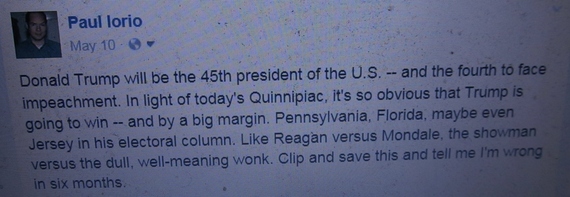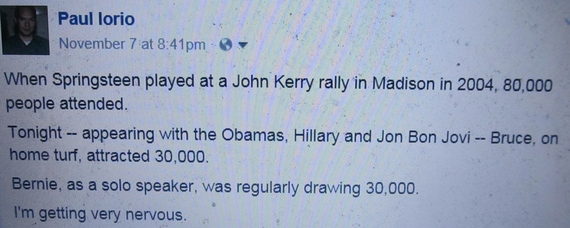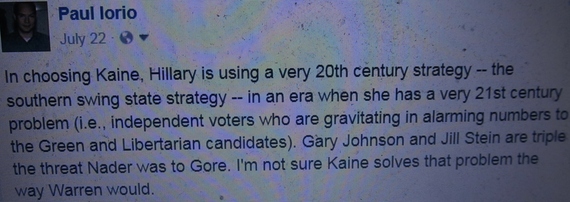My Journal of the Plague Year

On May 10, 2016, I predicted both a Trump victory -- and his eventual impeachment
Repeatedly, over the past sixteen months, I warned that Donald Trump would be elected president of the U.S.
"Donald Trump will be the 45th president of the United States -- and the fourth to face impeachment," I wrote in an electronically-dated comment on Facebook on May 10, 2016, around six months before the election. (Scroll through my timeline at Facebook.com/pauliorio.)
And nearly six-months later, days before the election, I called the electoral tally:

On November 4, 2016, I predicted unrest would follow Trump's election.
No one else agreed with me.
"Not happening," wrote a good friend in an email. It'll be a Hillary landslide, wrote journalistic colleagues on social media.
And, of course, almost all pollsters and pundits gave no credence to my prognostications.
I also predicted his election on my website The Daily Digression. And in my blogs published by The Huffington Post, I reported an alarming lack of enthusiasm for Hillary Clinton in the very blue San Francisco Bay Area ("Bernie Comes to Town and Doesn't Mention Hillary," October 17, 2016; "Campaign 2016: The View from the Epicenter of Progressivism," February 26, 2016 ).
In fact, as far back as July 7, 2015 -- that's 2015 -- I wrote "a president Trump is not out of the question."

From 2015, on Facebook.
And I stepped up my warnings in the final week of the campaign.
A tell-tale sign, I noted, was that Clinton was still trying to seal the deal in Michigan days before the election. That was like Trump trying to nail down Texas.

Another sign: only 30,000 people were drawn to Clinton's election-eve mega-rally in Philly with Jon Bon Jovi, the Obamas and Springsteen performing on his home turf. As I noted with original research, Springsteen drew 80,000 for John Kerry in Madison in 2004.

Springsteen drew 80,000 for Kerry in the mid-west, but only 30,000 for Clinton on his home turf? Red flag.
How did I catch what almost everyone else missed?
I paid closer attention to the polling of likely voters rather than of all voters.
I saw the enthusiasm of Trump supporters (and the lack of enthusiasm among Clinton backers) as an indicator that his voters would probably turn out in greater numbers.
And I factored in the wisdom of Yeats: "The best lack all conviction, while the worst are filled with a passionate intensity."
But mostly it was just my own political analysis that steered me right.
For example, I thought that Sen. Tim Kaine, as able as he is, was not the running mate to sop up the Bernie gravy of independent voters. On July 22, 2016, I wrote this:

As I noted, the southern swing state strategy was such a 20th century approach to a 21st century problem.

The only way to win was to put Sanders on the ticket to galvanize indie voters, I wrote.

In May 2016, I was already writing that the Dems had lost their best opportunity to beat Trump.
Another thing that tipped me off: my analyses of the vote totals after various primaries. Here's what I wrote on May 3, after the Indiana primary:

And, finally, I caught a more ambiguous whiff of the zeitgeist during the extraordinarily odd, overly emotional final game of the World Series, days before the election, when things were just starting to shift permanently for Trump. It seemed to me that America was expressing all that emotion for more than just a ball game. Here's what I wrote:
